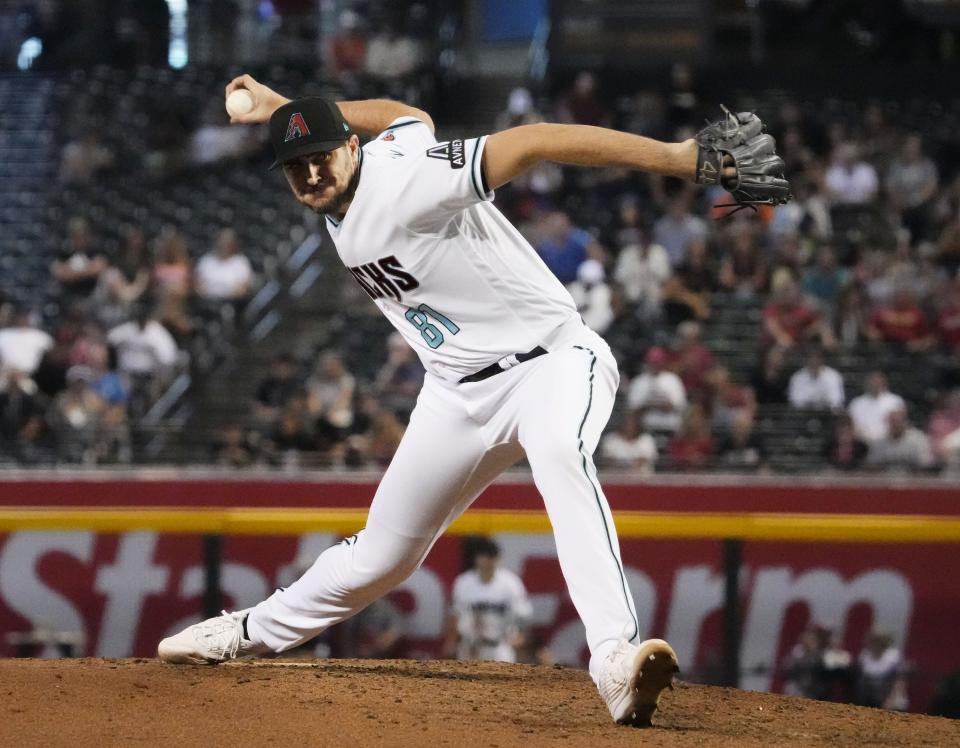How to explain Ryan Thompson’s success for Diamondbacks? Thank Byung-Hyun Kim
Watching Ryan Thompson pitch off a major-league mound is no doubt unusual, the way that he explodes into a crouch, whips his arm to the side and hurls the baseball towards home plate as if it’s a Wiffle ball. It’s enough to make an elbow shudder and a shoulder tingle.
It also pales in comparison to watching Thompson’s long-toss sessions. Deep in the outfield, hours before first pitch, Diamondbacks’ pitchers stand 100-some feet apart, throwing balls back and forth. It’s part of the daily drumbeat of baseball, so routine that it rarely deserves a second glance. That is, until Thompson starts his delivery. At the last second, he stops looking like every other pitcher and drops down to his side, sending a baseball flying impossibly far through the air from an arm slot the brain can hardly comprehend. The end result is normal. The path Thompson uses to get there is like watching someone get to the driver’s seat through the passenger door.
All of it begs the question as to why. Why does Thompson, whose signing helped resurrect the Diamondbacks’ suddenly lockdown bullpen, do this? The answer lies partly in a polarizing figure of the franchise’s past.
Growing up in rural Oregon, 10 miles south of Salem, Thompson’s childhood summers were almost cartoonishly idyllic. Early each summer, his two best friends would come over and fill binders writing down the rosters of major-league teams. Every day until school started again, the three would take those binders outside and play Wiffle ball in Thompson’s backyard, pretending to be the teams they idolized.

Home plate was a pitchback net with a taped-on strike zone. First base was a patch of dead grass. Second was a gutter. Third was a water well. But Thompson and his friends transformed the setting into a major-league park with their mannerisms. As baseball obsessives, they could mimic the batting stances and pitching mechanics of every name in those binders.
And none was more fun for Thompson than that of Byung-Hyun Kim. Two decades later, Kim might be best remembered for blowing leads in Games 4 and 5 of the 2001 World Series, giving birth to Derek Jeter’s "Mr. November" nickname in the process. But for much of his Diamondbacks’ tenure from 1999 to 2003, he was a dominant closer, fooling hitters with his trademark submarine style. Hundreds of miles away, Thompson discovered that his friends couldn’t touch him when he pitched like Kim.
“It was just the most fun,” Thompson said.
Plus, Kim was part of a Diamondbacks group that Thompson called “one of my favorite teams.” He loved Luis Gonzalez, another player with a unique style to mimic, and welcomed the young franchise ending the Yankees’ shot at a four-peat in 2001.
“Couldn't stand the Yankees so that whole World Series was awesome for me,” Thompson said.
But for years, Thompson left Kim’s unique style in the backyard. His dad, wary of injury and hesitant to embrace such an untraditional motion, had him pitch from an overhand slot.
Then, in the summer of 2008, Thompson went to a camp at Western Oregon University, searching for enough improvements to earn a spot on the varsity team as a junior at Cascade High School. A pitching coach there looked at how low Thompson’s legs crouched in his delivery and said a line that was music to his ears: “Your arm slot looks like it might be natural a little bit lower. Just try it and see what you think.”
“It was logical,” Thompson said. “And the results pretty much happened right away.”
That year, he was named to the all-conference team. As a senior, he was named to the all-region team. Increasingly, Thompson felt like he was deserving of a look in the MLB Draft. Instead, hidden in rural Oregon, he didn’t even get a Division I college offer. Only after succeeding at Chemeketa Community College did that offer finally come, from Campbell University.
The only reason he got that shot? The Big South, in which Campbell plays, had been dominated for years by a pair of sidearm pitchers at Coastal Carolina. Campbell wanted in on the action.
“The whole sidearm thing, it's me,” Thompson said. “Without it, I don't play Division I baseball and I don't play professional baseball.”
Thompson dominated at Campbell, working his way into a late-round draft pick. Six years later, he debuted in the major leagues with the Rays, helping them to the American League pennant as a rookie in 2020.

After three years of being a reliable contributor in Tampa, this year didn’t go as well. By August, he and his 6.11 ERA were designated for assignment.
“That's life,” Thompson said. “You're gonna hit road blocks and you've gotta figure out a way to get around it.”
With the Diamondbacks, Thompson has done that. In nine appearances, he hasn’t allowed a run. Before he debuted, the Diamondbacks’ bullpen ranked 24th with a 4.72 ERA. Since then, they’re fourth with a 2.34 ERA. The turnaround has been a group effort but no individual is more reliable than Thompson, who has given manager Torey Lovullo a reliable seventh inning option for the first time all year.
Live updates: News, updates from opener of Diamondbacks' series at Yankee Stadium
Much of that effectiveness can be tied to his delivery.
“The angle he creates is coming from behind a right-handed batter,” bullpen coach Mike Fetters said. “When you throw, most pitchers are within their shoulder width, just a little bit outside of it. He's way outside of it. So that deception he creates from his arm angle makes him pretty effective.”
In all of this, Thompson believes there’s a lesson to be learned.
“It's smart for kids to do this, don't be so locked in to one delivery,” Thompson said. “And for me to mimic probably 80 different people and throw like they throw, it really taught me to be able to make adjustments and to be fluid.”
Thankfully for Thompson and the Diamondbacks, one of those 80 people was Byung-Hyun Kim.
This article originally appeared on Arizona Republic: Diamondbacks' Ryan Thompson attributes success to Byung-Hyun Kim

